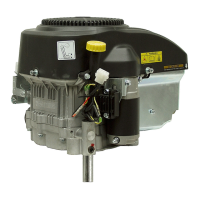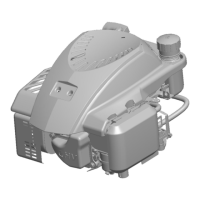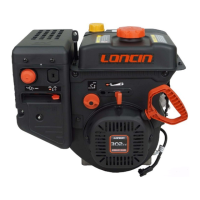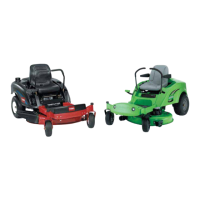ENGINE
40
Piston Ported Engine
In a piston ported en
ine, there are no reed valves.
The fuel/air mixture enters the crankcase throu
h a
third port that is opened and closed by the piston. (See
Fi
ure 66.) All other functions are the same as a reed
valve en
ine.
Figure 66
3297-001-2
Both Piston Ported and Reed Valve
Engines
At about 28 de
rees before top dead center (BTDC),
the spark plu
fires. When the en
ine is functionin
properly, the air/fuel mixture i
nites, causin
a burn
that occurs evenly throu
h the power stroke. (If the
compression ratio is too hi
h, the air/fuel mixture
actually explodes, which can be heard and is identified
as detonation.) The burn continues as the piston
chan
es direction and be
ins its travel towards the
crankcase. (See Fi
ure 67.)
Figure 67
3297-002
When the piston opens the exhaust port, hi
h-pressure
exhaust
ases exit the exhaust port. (See Fi
ure 68.)
Further movement of the piston towards the crankcase
uncovers the transfer port, which allows a fresh char
e
of oil/fuel mixture to enter the combustion chamber. As
the exhaust
ases continue to exit the exhaust port, the
en
ine is readied for another cycle. (See Fi
ure 69.)
Figure 68
3297-003
Figure 69
3297-004
The 2-cycle en
ine is always well lubricated as lon
as
the correct oil/fuel mixture is maintained in the fuel
tank. Oil suspended in the fuel vapor adheres to all
movin
parts, keepin
them continually coated,
re
ardless of operatin
an
le.
A. Intake Ports Closed
B. Compression
C. Third Port Closed
D. Partial Vacuum
A. Intake Ports Closed
B. I
nition
C. Third Port Open
D. Partial Vacuum
A. Intake Ports Closed
B. Exhaust Port Openin
C. Third Port Open
D. Pressure Buildin
Up
A. Intake Ports Open
B. Exhaust Port Open
C. Fresh Fuel Chan
e
D. Third Port Closed

